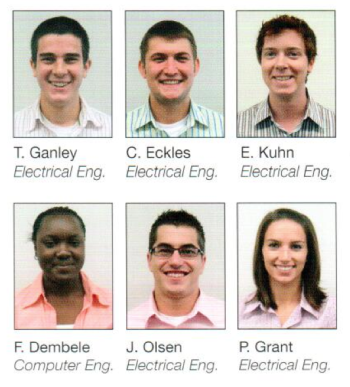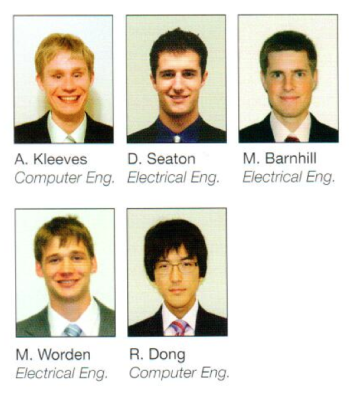Electrical Engineering
Projects
Electrical and Computer Engineering ECE 480 Senior Design is required of all electrical and computer engineering majors at MSU.
For information on becoming a project sponsor, please contact Gregg Motter.
The following are the project sponsors and projects for the fall of 2010:
MSU RCPD: Accessible Smart Grid Ready Wheelchair Battery Charger
 Team one’s project entailed the design and construction of a smart grid ready, accessible wheel chair charging device. The device will benefit consumers by optimizing charging cycles to occur primarily during ‘’off-peak” hours when electricity costs are lower. Additionally this device will feature accessible technologies to allow for ease of use by those who are disabled or otherwise impaired. While energy savings and “going green” are becoming more prevalent in today’s world, the burden of manually starting and stopping charging cycles can prove too much for some. Our charging optimizer will allow users to simply enter the desired charge completion time and walk away leaving the charger to handle charging optimization autonomously.
Team one’s project entailed the design and construction of a smart grid ready, accessible wheel chair charging device. The device will benefit consumers by optimizing charging cycles to occur primarily during ‘’off-peak” hours when electricity costs are lower. Additionally this device will feature accessible technologies to allow for ease of use by those who are disabled or otherwise impaired. While energy savings and “going green” are becoming more prevalent in today’s world, the burden of manually starting and stopping charging cycles can prove too much for some. Our charging optimizer will allow users to simply enter the desired charge completion time and walk away leaving the charger to handle charging optimization autonomously.
The charging optimizer will communicate with a household smart meter to receive data about charging times, energy rates, and grid load. Using this information the charging optimizer calibrates itself to charge only when energy is least expensive as well as to complete charging as quickly as possible.
In addition to this functionality, the charging optimizer features an easy-to-use accessible interface designed especially for those with physical limitations. Sight, sound, and motor skills deficiencies are all addressed by the interface design.
As an added bonus our project will be going to Jim Renuk an MSU employee who struggles with cerebral palsy. This device will help Jim save money each month on his electric bill and will guarantee that his chair is always charged when he needs it.
RCPD: Accessible Manufacturing Equipment Phase II
 Our design team is being sponsored by the MSU Resource Center for Persons with Disabilities (RCPD). We have reengineered an accessible manufacturing device, originally created by another capstone design team in the fall of 2008. This machine was designed to cut pleated ribbon to length and to be operated by someone with cognitive and visual disabilities. The machine will be deployed at a company called Lettuce Duit located in Galien, Ml, where the cut ribbons are used to construct prize ribbons.
Our design team is being sponsored by the MSU Resource Center for Persons with Disabilities (RCPD). We have reengineered an accessible manufacturing device, originally created by another capstone design team in the fall of 2008. This machine was designed to cut pleated ribbon to length and to be operated by someone with cognitive and visual disabilities. The machine will be deployed at a company called Lettuce Duit located in Galien, Ml, where the cut ribbons are used to construct prize ribbons.
Our team improved this machine by making it more robust, easier to maintain, and faster at cutting ribbons. We also added variable speed control, to allow the machine to run faster or slower as required. We eliminated previous motor overheating issues. We redesigned the interface and control systems to be compatible with LEGO MINDSTORMS NXT. This allows the machine to be reprogrammed by high school LEGO Robotics club students near where the machine will be deployed. We also added a variety of small improvements to reduce the time it takes to cut the ribbon as well as prevent the ribbon from catching on the machine.
Xilinx: FPGA Implementation of Driver Assistance Camera Algorithms
 Passenger safety is the primary concern and focus of automobile manufacturers today. In addition to the passive safety equipment, including seat belts and primary airbags, technology based active safety mechanisms are being incorporated more than ever and may be soon required by law. current trends are requiring automobile manufacturers to include a multitude of technology based safety equipment including ultrasonic sensors and back-up cameras. Historically, back-up cameras in vehicles give the driver an unaltered view from behind the vehicle; however, with the sponsorship of Xilinx, Michigan State University’s ECE 480 Team 3 has designed and implemented an algorithm that will visually alert the driver to objects seen in the back-up camera.
Passenger safety is the primary concern and focus of automobile manufacturers today. In addition to the passive safety equipment, including seat belts and primary airbags, technology based active safety mechanisms are being incorporated more than ever and may be soon required by law. current trends are requiring automobile manufacturers to include a multitude of technology based safety equipment including ultrasonic sensors and back-up cameras. Historically, back-up cameras in vehicles give the driver an unaltered view from behind the vehicle; however, with the sponsorship of Xilinx, Michigan State University’s ECE 480 Team 3 has designed and implemented an algorithm that will visually alert the driver to objects seen in the back-up camera.
This platforms draws the driver’s attention to objects both stationary and in-motion behind the vehicle by marking them with targets. In doing so, the driver will be less likely to overlook objects that may create a safety hazard. The team has combined knowledge of edge detection, object detection and image clarity algorithms to create a system that will both accurately and efficiently detect and visually alert the driver to objects behind the vehicle. Implementation of the algorithm utilizes Xilinx’s Spartan-3A Field Programmable Gate Array (FPGA) development board and Xilinx’s System Generator tools.
Texas Instruments: DC Motor Control Card
 The goal of our project is to develop a motor control card and supporting software using technology provided by Texas Instruments. Texas Instruments had already designed a motor control card and software utilizing the C2000 family of 32-bit microprocessors. our task was to adapt this existing design to make use of the MSP430 family of 16-bit microprocessors. This was a challenge because the software conventions and protocols as well as hardware footprint are significantly different between the two families.
The goal of our project is to develop a motor control card and supporting software using technology provided by Texas Instruments. Texas Instruments had already designed a motor control card and software utilizing the C2000 family of 32-bit microprocessors. our task was to adapt this existing design to make use of the MSP430 family of 16-bit microprocessors. This was a challenge because the software conventions and protocols as well as hardware footprint are significantly different between the two families.
The project required us to design a motor control card to exactly to specifications. The MSP430 micro controller interfaces with TI’s DRV8412 motor driver card through a Dual Inline Memory Module slot. This plug-and-play DIMM protocol allows for the motor to be driven by completely different architectures without requiring redundant design. Although we worked to maintain equivalent functionality, we also worked to take advantages of the difference between the MSP430 and the C2000. One of the main motivations for the use of the MSP430 is its extremely low power consumption. In fact, MSP430s can run off of just the acidity of grapes.
After this card was created, software was created for controlling both brushed DC motors and stepper motors. The software is capable both of simple motor spinning operations as well as advanced control using current feedback.
Hyundai-Kia America Technical Center: Automobile Headlamp Switching Using Smart Glass
 Team 5 has been charged with determining how to use smart glass to switch an automobile’s high beams on and off. “Smart glass” is a generic term describing types of glass which, when electrically stimulated, can change between opaque and clear states, which absorb or transmit light, respectively. Currently, cars that use HID headlamps rely on a mechanical system where a solenoid moves a metal shield into the path of the light, physically blocking the “high” portion of the beam. This mechanism is not ideal because it lack flexibility and requires manufacturers to fabricate and install different headlamps to satisfy the requirements for left-and-right headlamps, and the different American and European standards for beam patterns. Replacing the metal shield with a smart glass panel would overcome these disadvantages and allow the manufacturer to come another step closer to building a “world car” for the global market.
Team 5 has been charged with determining how to use smart glass to switch an automobile’s high beams on and off. “Smart glass” is a generic term describing types of glass which, when electrically stimulated, can change between opaque and clear states, which absorb or transmit light, respectively. Currently, cars that use HID headlamps rely on a mechanical system where a solenoid moves a metal shield into the path of the light, physically blocking the “high” portion of the beam. This mechanism is not ideal because it lack flexibility and requires manufacturers to fabricate and install different headlamps to satisfy the requirements for left-and-right headlamps, and the different American and European standards for beam patterns. Replacing the metal shield with a smart glass panel would overcome these disadvantages and allow the manufacturer to come another step closer to building a “world car” for the global market.



